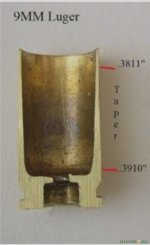Awhile back there was a thread on why sometimes the pistol bullet bulges the case. I had to change shell holders for 9mm and got involved in what turned into an hours long effort to get everything back into adjustment. Some observations:
The actual intent of handgun cartridge sizing dies is to produce an inside diameter of the case that will provide proper tension on the bullet so it stays in place during the feed cycle/recoil. That tension also affects powder burn and velocity variation. However, it does that by squeezing the outside diameter of the case and there's the problem.
Case wall thickness varies for all cases. Just grabbing a few 9mm cases of various makes I found that case wall thickness ran from a smidgen under 0.010 in to 0.014 inches. Most ran in the 10-12 range and the differences will double any diameter variation. The good folks who make reloading dies have to make their stuff to work on everything. (OK, they may make make dies for the major manufacturers, but those are likely to their specifications.)
Obviously, if you make your sizing dies so that they'll work on thin brass, they'll oversize thicker brass. Then, when you stick a bullet in there, the case ends up a larger diameter than what's below the bullet. OK, it may look a tad funny, but it works. OBTW, factory ammo is that way too, it's just that the differences are smaller because they know what their case wall thickness is and create their tooling to suit. They're also working with virgin brass.
I may need to fine tune the crimp adjustment due to case overall length variations. New Starline is correct length, some other brands seem a bit short, may be lot to lot variation.
The actual intent of handgun cartridge sizing dies is to produce an inside diameter of the case that will provide proper tension on the bullet so it stays in place during the feed cycle/recoil. That tension also affects powder burn and velocity variation. However, it does that by squeezing the outside diameter of the case and there's the problem.
Case wall thickness varies for all cases. Just grabbing a few 9mm cases of various makes I found that case wall thickness ran from a smidgen under 0.010 in to 0.014 inches. Most ran in the 10-12 range and the differences will double any diameter variation. The good folks who make reloading dies have to make their stuff to work on everything. (OK, they may make make dies for the major manufacturers, but those are likely to their specifications.)
Obviously, if you make your sizing dies so that they'll work on thin brass, they'll oversize thicker brass. Then, when you stick a bullet in there, the case ends up a larger diameter than what's below the bullet. OK, it may look a tad funny, but it works. OBTW, factory ammo is that way too, it's just that the differences are smaller because they know what their case wall thickness is and create their tooling to suit. They're also working with virgin brass.
I may need to fine tune the crimp adjustment due to case overall length variations. New Starline is correct length, some other brands seem a bit short, may be lot to lot variation.
Last edited:




